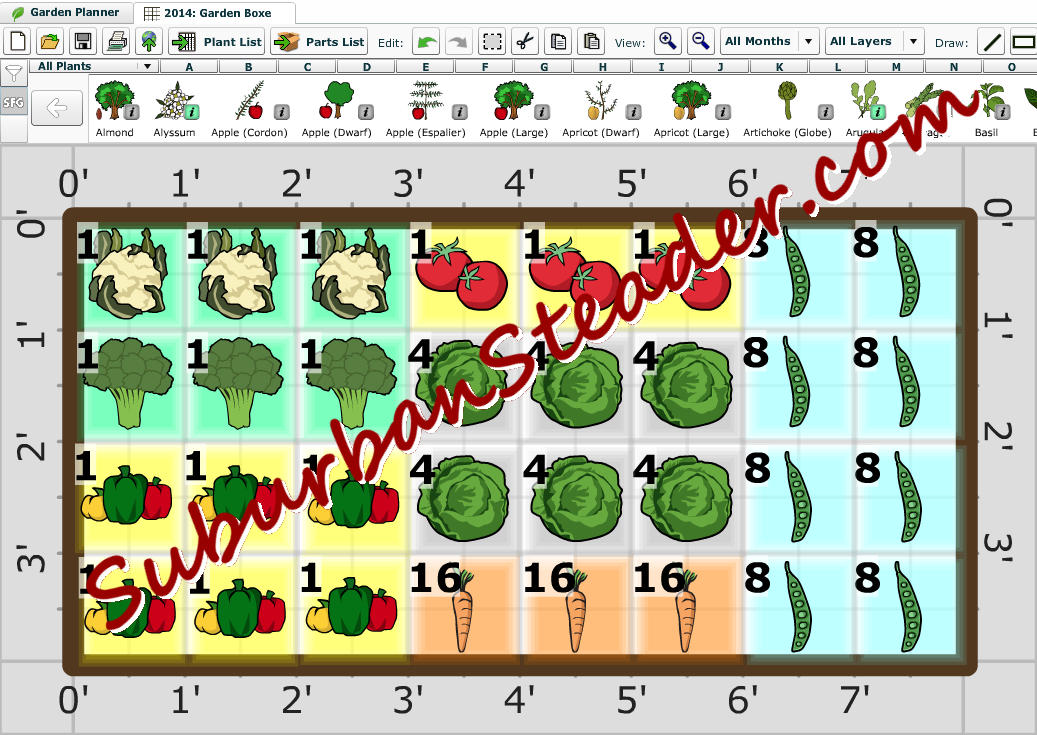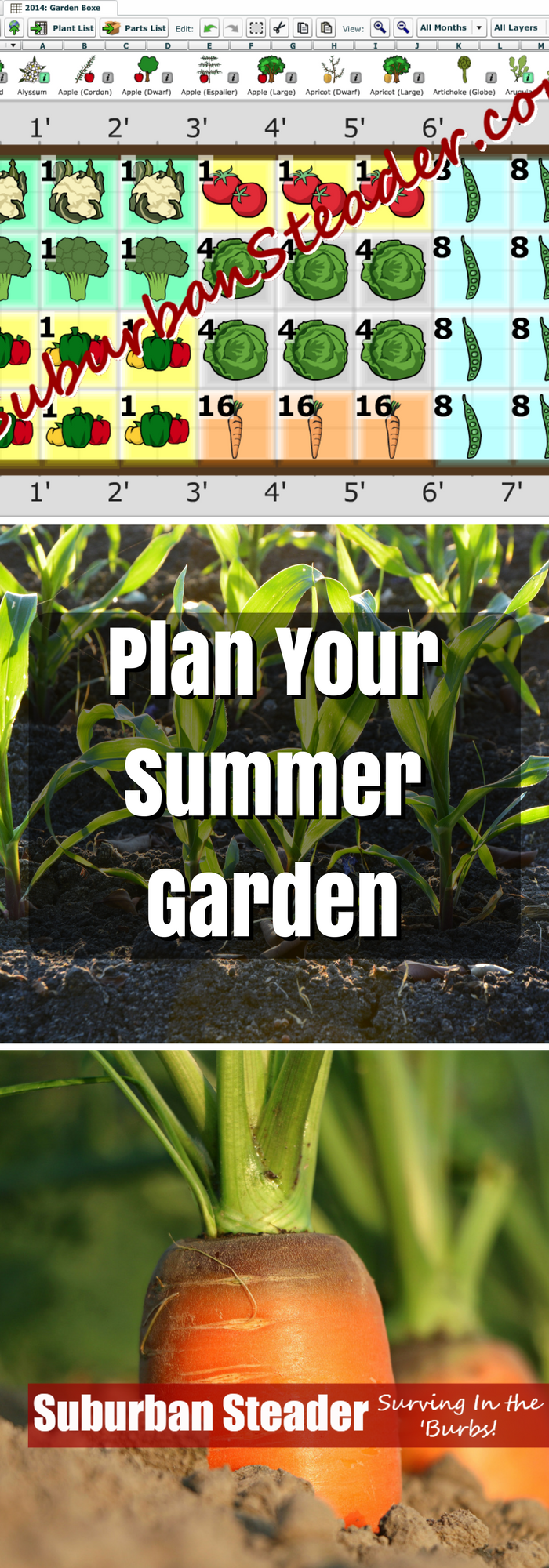Plan Your Summer Garden
Over the last few weeks, I’ve talked about Finding Room to Homestead and how to perform a Suburban Homestead Site Survey. Now that you know how you’re going to approach your suburban homestead and where on your land you’ll be conducting different suburban homesteading activities, it’s time to plan your summer garden.
For most suburbanites, setting up a garden is the first step to a suburban homestead. Guidance from The Weekend Homesteader is quite useful in making sure that you avoid a few pitfalls and are aware of a couple of tricks and tips for this otherwise simple task. With that thought in mind, we’ll be covering the following topics in this post as well as talking about how we implement these areas of knowledge on the Suburban Steader Homestead:
- Garden Size
- Garden Location
- Garden Layout
- Simple Vegetables and Herbs
Garden Size
If you remember one thing from this post, remember this:
You don’t set and forget a garden
You will be working this area extensively throughout the season – weeding, harvesting, planting and maintaining. The reason I emphasize this point is because the biggest mistake you can make when you plan your summer garden is to bite off more than you can chew. Designing a space that is too large will be more detrimental to your suburban homesteading success.
Why is too big worse than too small you ask?
The answer lies in availability of time. You only have a certain amount of time that you can spend gardening. This fact is especially true with suburban homesteaders as they are not working the homestead all day, every day. Typically a garden is a weekend and/or after work activity for most of you.
So, how big of a garden should you build?
If you’ve never gardened before, I suggest you plan your summer garden in an area that is roughly four (4) feet by eight (8) feet. This approach will give you forty-eight (48) square feet of gardening space. Anything more than that is going to be too intimidating. You can have a few side items if you like outside of this area (potted tomatoes, blueberry bushes, etc.) but the majority of gardening should happen in this area.
Note that Anna Hess disagrees with me. She recommends beginners can go up to one hundred forty-four (144) square feet – three times what I recommend! All I can say to that is remember that it’s always easier (mentally and physically) to expand your garden than decrease its size.
Suburban Steader Homestead Garden Size
For the last half decade or so, I’ve used a roughly forty-eight square foot area for my garden. By using the space efficiently – I implement Square Foot Gardening principles – I have successfully offset my family’s vegetable consumption by a significant margin. Please do not take that to mean that we are anywhere near self-sufficient.
I’ve doubled our garden space this year with the addition of a four foot by eight foot raised bed. In addition, I have some perennials (blueberries, strawberries, etc.) on other locations which are above and beyond this ninety-six square feet of garden area we now have.
Garden Location
In my last post, I talked extensively about how to lay out your suburban homestead based upon a long list of factors. There’s not much more to be said here that hasn’t been outlined in that post. The one bit of advice I would give is to plan your summer garden so that it is not far from the house. The closer you are to your garden, the more apt you will be to work on it and the better success you will experience.
Suburban Steader Homestead Garden Location
As you’ve seen in this picture, the new garden box I put in is right next to our patio. The old garden box is about as far away from the patio as you can get on my land. This update is already paying dividends. I spend a few minutes each day tending to the closer garden box whereas I don’t walk out to the other one as much. This little bit of knowledge has taught me that I’m going to put the more needy crops in the closer box.
Garden Layout
I have two main tips when you plan your summer garden on your suburban homestead:
- Remember the Two Foot Rule
- Visual Record Keeping
The Two Foot Rule
This rule is something I learned from Mel Bartholomew in his Square Foot Gardening principles. Most people cannot reach into a bed more than two feet. If you design your garden so that you can reach every piece of soil with this rule in mind, you’ll never have to walk on your garden (compressing the soil) and you’ll be able to utilize all your land. That’s part of the reason I recommend four foot by eight foot beds. As long as the maximum dimension on one side is four feet, you’ll be able to reach the middle on either side.
Visual Record Keeping
I’ll be perfectly honest – I have a crappy memory.
I can’t remember what I planted or where I planted it, especially if I’m starting from seed. That is why I use a visual record keeping system. Not only does it remind me of what I planted where, but I can track when I planted it, how many plants/seeds I planted and plan accordingly.
I use a piece of software called Garden Planner from GrowVeg.com. While I’m a kind of tech geek, there’s nothing wrong with good old paper and pencil to keep track of your garden layout.
Simple Vegetables and Herbs
All this work to plan your summer garden and you don’t even know what you’ll be growing yet. Not any longe!.
It’s time to pick your produce!
As a novice gardener, Anna Hess and I agree that picking simple, easy to grow vegetables will give you early wins and build your confidence. With that thought in mind, we recommend the following items:
- Swiss Chard – A summer green that is virtually work free. Cooks up like spinach but much easier to grow.
- Summer Squash (inc. Zucchini) – Big and beefy, these veggies will provide you with lots of produce as well as lots of confidence. There’s something boastful about growing a plant as big as summer squash can get. With that in mind, summer squash does take up a lot of room, so if space is at a premium, you might want to think this one over.
- Green Beans – Quick to sprout and quick to harvest, these guys will give you a quick, bountiful victory. Bush beans don’t need a trestle but will grow very quickly meaning you’ll be replanting a lot.
- Tomatoes – They love sun! While they’re a bit more finicky than some of the other veggies mentioned, you can’t beat the taste of a homegrown tomato. Buy them in seedling sets and plant them deep. Too much water is a problem for these guys.
- Mint – A quick grower and a perennial to boot! Mint will take over your garden if you’re not careful so make sure you have a root barrier in place or, better yet, start it in a pot.
- Basil – Drop the seeds, water and walk away. You’ll have fragrant leaves all summer.
Anna also recommends okra – I can’t really comment on that as I’ve never grown it. I will say that the items I would add to the list are romaine lettuce and broccoli. Both grow rather easily from either seed or seedlings.
The most important thing to do when picking what you grow is remembering what you eat. It’s a shame to grow tomatoes if your family dislikes them. At best, you’ll have a harvest and not know what to do with it and, at worst, you won’t work your garden because the outcome doesn’t interest you.
Wrap-Up
There you have it – how to plan your summer garden in a few simple steps. Remember that, at the end of it all, gardening should be a relaxing endeavor, not something you feel is a chore. That’s not to say it’s not a lot of hard work, but if you find yourself resenting the garden, take a step back and figure out why. You should be enjoying this work – you get to reap all the rewards!
Please let us know any tips you have for planning your summer garden in the comments or on our Facebook Page.
